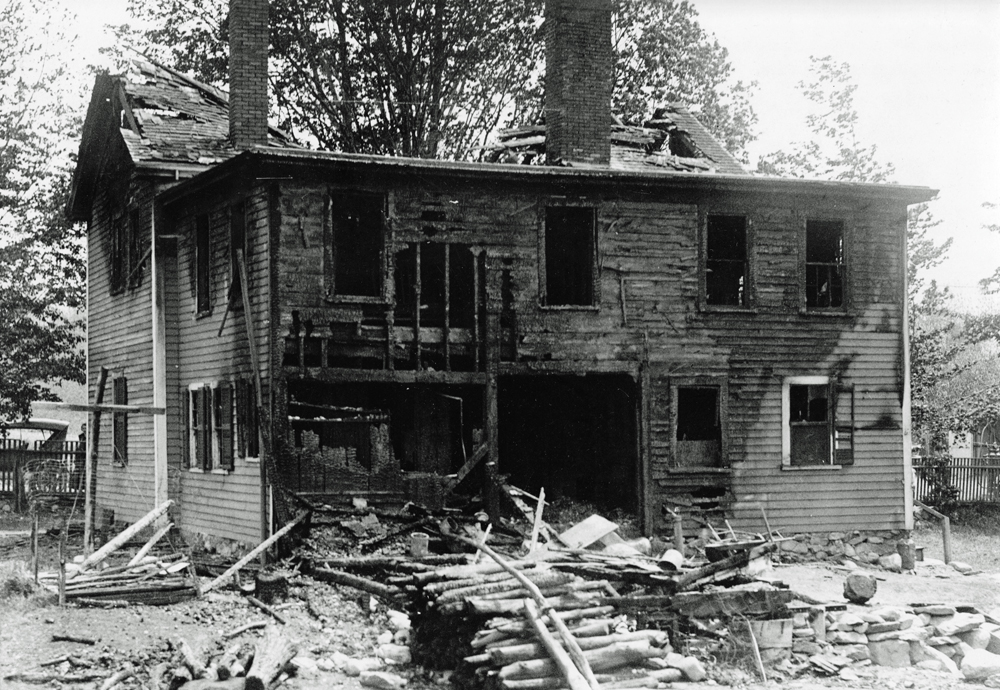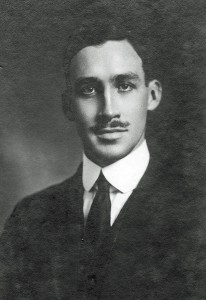True Tales from Canton’s Past: Ponkapoag Fire Part 2
By George T. ComeauThe following is the second in a two-part series on the Ponkapoag Fire of 1924. Click here for part 1.
The crowd that gathered in front of the house at 2246 Washington Street stood by helplessly and watched as fire engulfed the two-story wooden structure. Trapped inside were seven people who clung to life as rescuers began frantic efforts to secure a ladder.
The Ponkapoag fire of May 1924 would be one of the worst in Canton’s history. This was a watershed moment in the evolution of the fire department, and one that from tragedy would create a modern and professional fire service in our town.
As the fire engine rounded the corner at Crowell’s Market, the driver, Charles Bryant, called for the men to drop the hose off at the hydrant so that as he drove the 500 feet to the fire he could extend the water line to the scene. But when they arrived moments later, the hose was still in the truck — the men had failed to drop the line at the hydrant. Losing precious time, the truck proceeded to Green Lodge Street and laid a line from that second hydrant. Two men used a wrench to open the hydrant, yet by accounts of witnesses they tightened rather than loosened the valve, breaking the wrench in the process. Water failed to flow and the cries of the children rang through the night. The firemen abandoned the hydrant and returned to the one at Crowell’s, where a rock in the hydrant line blocked the free flow of water. Precious time was lost due to the inept fire brigade and lack of training and equipment.
Meanwhile, Officer Joseph Cunningham of the Canton Police Department was searching for a ladder to find another way into the inferno. Recalling that a ladder was at Crowell’s Store, he ran to get it as his lungs burned from the smoke he had inhaled. Collapsing from fatigue, Cunningham needed help. It was a neighbor, Frank Kendall, who ran the ladder back to the scene, where he climbed up to save the children. Kendall later testified that he “could not enter because of the smoke and flames and could detect no sign of any person in the room.”
By that point the children had passed out, overcome by smoke — the twins clinging together and embraced in each other’s arms. They could not be found in the thick smoke and heat of the fire. A second alarm would have to be struck in order to get additional help to the scene. Put simply, the on-call firemen seemed to be doing more harm than good. Without a working pumper and no ladders or gas masks, they were sorely under-equipped to deal with the blaze.
A fireman went to the alarm box and placed a second alarm, yet the central fire station assumed that it was simply another alarm for the Ponkapoag crew. It would take a phone call from a house near the scene to convey the magnitude of the need at Ponkapoag. Within minutes the permanent firemen at Canton Center began to assemble. The forest auto was filled with 600 feet of hose, 14 extinguishers, a 15-foot roof ladder, axes and gas masks. Professional help was on the way. The general alarm rang out from Plymouth Rubber; the entire town knew something horrible was underway. When the firemen from the main station house arrived, they immediately opened the Green Lodge Street hydrant and water began to flow.
But it was too little, too late. There was no hope for the mother and the six children. “It was a seething furnace,” declared one resident. The heat was so intense that neighbors had to stand across the road to “escape from being scorched.” Everyone realized in an instant that a woman and six children were being burned to death. By 3 a.m., 35 minutes had passed and the fire still raged out of control.
The deaths made national news, including photos of the children and coverage by the New York Times. The Boston Globe demanded “a probe of the whole sorry affair.” The next day, a clock was found in the D’Attanasio kitchen — the clock and the lives of seven people stopped at 2:55 a.m. on May 24, 1924.
In the aftermath of the tragedy it was discovered that the second alarm had never been sounded. The alarm boxes at that time had a smaller box within the larger one, and only engineers of the fire department and permanent police officers had the keys to ring the second alarm. A board of inquiry was assembled as the townspeople demanded answers.
Within days the state Department of Public Safety convened at the Ponkapoag Fire Station and called witnesses. Chief of Police John Flood, officers Ronayne and Cunningham, as well as Selectman Charles K. Endicott spent the entire day at the proceedings. Vincenzo D’Attanasio, who lost his wife and two children in the blaze, gave his testimony, as did Joseph and Rosella LeCleire, who lost their four children.
The selectmen took immediate action; on June 10, they removed Clinton Curtis and Cornelius Callahan from the fire department. Prior to the fire they had already removed the chief, Eugene Reilly. A full reorganization was put into place with a new fire board consisting of all three of the selectmen and three additional seasoned firemen. Within weeks, Selectman Charles Endicott was named chief — a position that he held for the next 15 years. Endicott would become the person who most effectively transformed and modernized the department.
The entire personnel budget for fire safety in 1924 was $6,434, with more than half going to “chauffeurs” to simply drive the apparatus to the fire. As for equipment, at the time of the fire the pumper that had been lost in 1918 had yet to be replaced. Just a week before, one of the engines that carried ladders was out of commission. A new appropriation was made to purchase a modern pumping engine, which had the ability to throw 750 gallons of water per minute. It took a special town meeting in April 1925 to authorize the purchase of a new pumper and a hook and ladder for $19,989. The American LaFrance, which was acquired in June 1925, would serve for many years and can still be seen today as an historic piece of equipment.
Under Chief Endicott, the department was reorganized with the central station call men placed into two companies: a ladder company directed by Engineer Captain William Curtis and an engine company in the charge of Captain William Whitty. Summer training meetings were held every Thursday night at the Third Pond — a practice that continued for the next 40 years. In 1926 town meeting voted to hire a third permanent man, Fred Olson, to join the other two at the central station. At the same time a new chassis replaced the one on the ten-year-old Kissel Kar at Ponkapoag. The next year a six-cylinder, one-and-a-half-ton Reo with a long wheel base chassis was purchased for Ponkapoag from Haynes Garage for $1,500. In 1928 the pay of the permanent men was set at $5.50 per day and that of the call men was raised from $75 to $125 per year. That year also saw $7,976 spent for the installation of an entirely new fire alarm system and the erection of a small addition at the central station to house the larger apparatus. Within five years of the fire the town was well equipped and under the control of a master chief.
After the fire, the aftermath and shock set in. At St. Mary’s Cemetery the D’Attanasio family gathered to lay to rest Annantonia and her children. On her grave is engraved “Victims of the Ponkapoag Fire.” To this day, 90 years later, Albert’s sons still visit the grave and place flowers in memory of the tragedy that befell their family.
Vincenzo and his son Albert returned to Italy where the little boy was left in the care of his grandmother in the hillside village where Vincenzo had grown up. Vincenzo later returned to America and remarried. It is likely that Albert returned to Canton aboard the S.S. Colombo from Naples in March 1925. Both brothers Tomasso and Vincenzo naturalized in 1934 and 1943, respectively. Beginning a second life, Albert graduated from Canton High School and became one of our prominent citizens. Albert was a member of the School Committee and Planning Board and served as commander of the American Legion. In service to his country, Albert was an Italian language interpreter, and family folklore tells stories of him inviting captured POWs that were barracked in Boston Harbor to his home in Canton on Pequit Street.
Al and Paul D’Attanasio have fond memories of their father, but “he never spoke of the fire,” they explain. Paul calls the fire “a series of comical errors,” and Al has saved yellowed newspaper clippings from the day. Both men want the memory of their family to live on in the town their dad loved so much. Not much is known of what became of Joseph and Rosella LeCleire. Their life would have been in turmoil with the loss of their four children, who were also buried at St. Mary’s.
Today, in Ponkapoag sits a field with a majestic oak tree that grew in the yard of the house. The tree is reaching for the sky and stands as a memorial to the seven lives lost in a conflagration that forever changed our small town.
Special thanks to Paul and Al D’Attanasio for kind assistance with this story.
Short URL: https://www.thecantoncitizen.com/?p=26012












